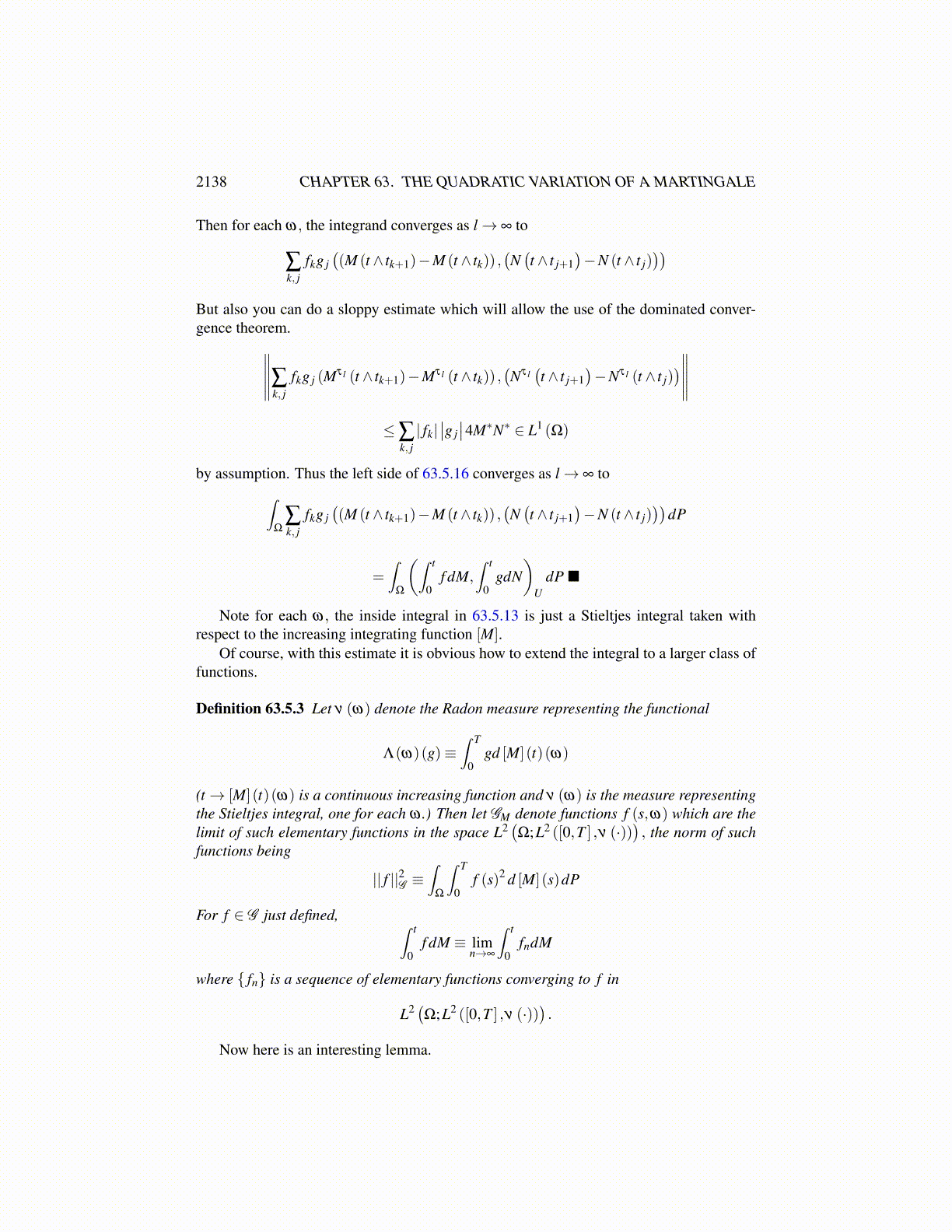
2138 CHAPTER 63. THE QUADRATIC VARIATION OF A MARTINGALE
and it is clear that{∫ t
0 f dMτ l}
is a martingale because it is just the sum of some martin-gales. Thus {τ l} is a localizing sequence for
∫ t0 f dM. It is also clear
∫ t0 f dM is continuous
because it is a finite sum of continuous random variables.Next consider the formula which is really a version of the Ito isometry. There is no loss
of generality in assuming the mesh points are the same for the two elementary functionsbecause if not, one can simply add in points to make this happen. It suffices to consider63.5.14 because the other formula is a special case. To begin with, let {τ l} be a localizingsequence which makes both Mτ l and Nτ l into bounded martingales. Consider the stoppedprocess.
E((∫ t
0f dMτ l ,
∫ t
0gdNτ l
)U
)
= E
((n−1
∑k=0
fk (Mτ l (t ∧ tk+1)−Mτ l (t ∧ tk)) ,
n−1
∑k=0
gk (Nτ l (t ∧ tk+1)−Nτ l (t ∧ tk))
))To save on notation, write Mτ l (t ∧ tk+1)−Mτ l (t ∧ tk)≡ ∆Mk (t) , similar for ∆Nk. Thus
∆Mk = Mτ l∧tk+1 −Mτ l∧tk ,
similar for ∆Nk. Then the above equals
E
(n−1
∑k=0
(fk∆Mk,
n−1
∑k=0
gk∆Nk
))= E
(∑k, j
fkg j (∆Mk,∆N j)
)Now consider one of the mixed terms with j < k.
E (( fk∆Mk,g j∆N j)) = E(E(( fk∆Mk,g j∆N j) |Ftk
))= E
(g j∆N j, fkE
(∆Mk|Ftk
))= 0
since E(∆Mk|Ftk
)= E
((Mτ l (t ∧ tk+1)−Mτ l (t ∧ tk)) |Ftk
)= 0 by the Doob optional sam-
pling theorem. Thus
E((∫ t
0f dMτ l ,
∫ t
0gdNτ l
)U
)= (63.5.15)
=n−1
∑k=0
E ( fkgk (∆Mk,∆Nk)) =n−1
∑k=0
E ( fkgk ([∆Mk,∆Nk]+Nk)) (63.5.16)
where Nk is a martingale such that Nk (t) = 0 for all t ≤ tk. This is because the martin-gale (Nτ l )tk+1 − (Nτ l )tk = ∆Nk equals 0 for such t; and so E (Nk (t)) = 0. Thus fkgkNkis a martingale which equals zero when t = 0. Therefore, its expectation also equals 0.Consequently the above reduces to
n−1
∑k=0
E ( fkgk [∆Mk,∆Nk]) .